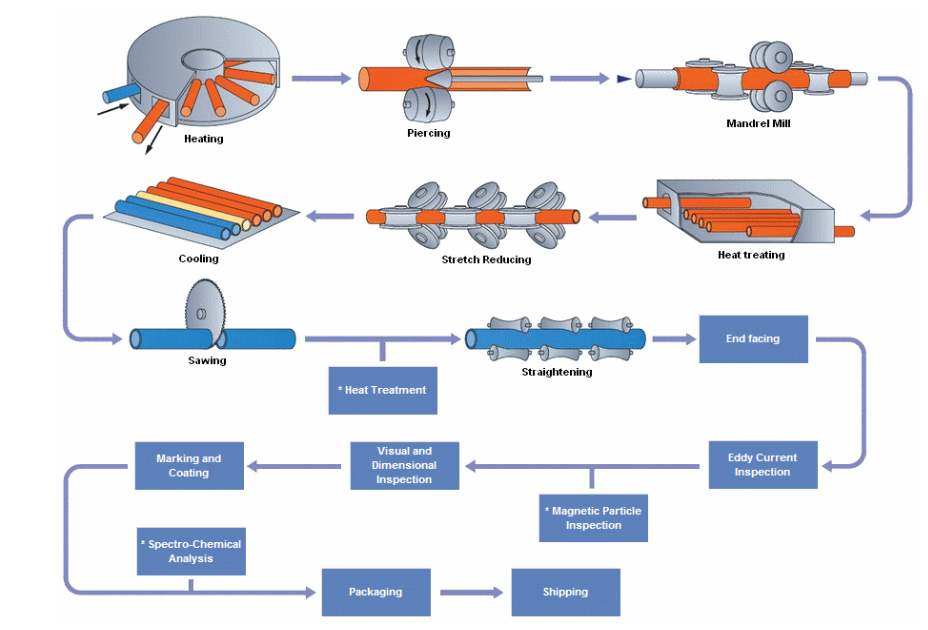Zhengzhou Huitong Pipeline Equipment Co.,Ltd. |
|
Pickling 1/2''-48'' Seamless ASTM B161 UNS N02201 Nickel 201 tube and pipe
1 Overview:
Nickel 200 (UNS N02200/W.Nr. 2.4060 & 2.4066) is commercially pure (99.6%) wrought nickel. It has good mechanical properties and excellent resistance to many corrosive environments. Other useful features of the alloy are its magnetic and magnetostrictive properties, high thermal and electrical conductivities, low gas content and low vapor pressure. Chemical composition is shown in Table 1. The corrosion resistance of Nickel 200 makes it particularly useful for maintaining product purity in the handling of foods, synthetic fibers, and caustic alkalies; and also in structural applications where resistance to corrosion is a prime consideration. Other applications include chemical shipping drums, electrical and electronic parts, aerospace and missile components.
Commercially pure wrought Nickel with good mechanical properties over a wide range of temperature and excellent resistance to many corrosives, in particular hydroxides.
Good resistance to corrosion in acids and alkalis and is most useful under reducing conditions. Outstanding resistance to caustic alkalis up to and including the molten state. In acid, alkaline and neutral salt solutions the material shows good resistance, but in oxidizing salt solutions severe attack will occur. Resistant to all dry gases at room temperature and in dry chlorine and hydrogen chloride may be used in temperatures up to 550C. Resistance to mineral acids varies according to temperature and concentration and whether the solution is aerated or not. Corrosion resistance is better in de-aerated acid.
Characteristics
Ni 200 can be hot rolled into practically any shape, and it also responds well cold forming, and machining, as long as established practices are followed. It is also accepts most conventional welding, brazing, and soldering processes.
While Ni 200 is made almost exclusively from nickel (at least 99%), it also contains trace amounts of other chemical elements including:
Nickel(pluscobalt)......................................................99.0 min. Copper........................................................................0.25 max. Iron..............................................................................0.40 max. Manganese.................................................................0.35 max. Carbon........................................................................0.15 max. Silicon.........................................................................0.35 max. Sulfur ..........................................................................0.01 max.
Mechanical Property Requirements
| Ultimate Tensile | Yield Strength (0.2% OS) | Elong. | R/A | Hardness | |
| Cold Worked | |||||
| Min | 75 KSi | 50 KSi | 15 | ||
| Max | |||||
| Min | 515 MPa | 345 MPa | |||
| Max | |||||
| Hot Worked | |||||
| Min | 55 KSi | 15 KSi | 40 | ||
| Max | |||||
| Min | 380 MPa | 105 MPa | |||
| Max | |||||
Specifications
| Form | Standard |
| Metal Type | UNS N02200 |
| Bar | ASTM B160 Din 17752 BS 3076 |
| Wire | |
| Sheet | ASTM B162 Din 17750 BS 3072 |
| Plate | ASTM B162 Din 17750 BS 3072 |
| Tube | ASTM B622 ASTM B161 ASTM B163 Din 17740 BS 3074 |
| Pipe | ASTM B622 ASTM B161 Din 17740 BS 3074 |
| Fitting | ASTM B366 |
| Forging | ASTM B564 |
| Weld Wire | ERNi-CI |
| Weld Electrode | ENi-1 |
| NA 11 | All forms |
| Din | 2.4066 All forms |
2.Wall thickness testing for Nickel Alloy G-30 ASTM B622 UNS N06030 Hastelloy G30 seamless pipe:


3.Process for ASTM B161 UNS N02201 Nickel 201 tube and pipe:

4.DIFFERENCE BETWEEN TUBE AND PIPE
Is It a Pipe or a Tube?
In some instances the terms may be used interchangeably, however
there is one key difference between tube and pipe, particularly in
how the material is ordered and toleranced. Tubing is used in
structural applications so the outside diameter becomes the
important dimension. Tubes are often put into applications such as
medical devices that require precise outside diameters. The outside
diameter is important since it will indicate how much it can hold
as a stability factor. Where as pipes are normally used to
transport gasses or liquids making it important to know the
capacity. Knowing how much can flow through the pipe is key. The
circular shape of the pipe make it efficient when handling pressure
from the liquid flowing through.
Classification
The classification of pipes are schedule and nominal diameter. Pipe
is typically ordered using the Nominal Pipe Size (NPS) standard and
by specifying a nominal diameter (pipe size) and schedule number
(wall thickness). The schedule number can be the same on different
size pipe but the actual wall thickness will be different.
Tubes are typically ordered to outside diameter and wall thickness; however, it may also be ordered as OD & ID or ID and Wall Thickness. The strength of a tube depends on the wall thickness. The thickness of a tube is defined by a gauge number. Smaller gauge numbers indicate larger outside diameters. The inside diameter (ID) is theoretical. Tubes can come in different shapes such as square, rectangular and cylindrical, whereas Pipe is always round. The circular shape of the pipe make the pressure force evenly distributed. Pipes accommodate larger applications with sizes that range from a ½ inch to several feet. Tubing is generally used in applications where smaller diameters are required.
Ordering Your Tubing or Pipe
Tubing is typically ordered to outside diameter and wall thickness;
however, it may also be ordered as OD & ID or ID and Wall
Thickness. Although tubing has three dimensions (O.D., I.D. and
wall thickness) only two may be specified with tolerances and the
third is theoretical. Tubing is usually ordered and held to tighter
and more stringent tolerances and specifications than pipe. Pipe is
typically ordered using the Nominal Pipe Size (NPS) standard and by
specifying a nominal diameter (pipe size) and schedule number (wall
thickness).